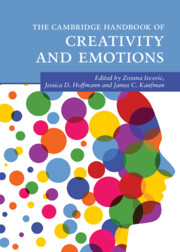Book contents
- The Cambridge Handbook of Creativity and Emotions
- Cambridge Handbooks in Psychology
- The Cambridge Handbook of Creativity and Emotions
- Copyright page
- Dedications
- Contents
- Figures
- Tables
- Contributors
- Acknowledgments
- Creativity and Emotions
- Part I Methods in the Study of Creativity and Emotions
- Part II The Development of Creativity
- Part III Emotions and the Creative Person
- 12 Emotion Traits and Creativity
- 13 Gender Differences in Creativity and Emotions
- 14 Affect in Pretend Play and Creativity
- 15 Creativity, Emotions, Emotion Regulation, and Aging
- 16 Interpersonal Relationships, Social Emotions, and Creativity
- Part IV Emotions and Creative Products
- Part V Emotions and Creativity at School and Work
- Index
- References
13 - Gender Differences in Creativity and Emotions
from Part III - Emotions and the Creative Person
Published online by Cambridge University Press: 16 February 2023
- The Cambridge Handbook of Creativity and Emotions
- Cambridge Handbooks in Psychology
- The Cambridge Handbook of Creativity and Emotions
- Copyright page
- Dedications
- Contents
- Figures
- Tables
- Contributors
- Acknowledgments
- Creativity and Emotions
- Part I Methods in the Study of Creativity and Emotions
- Part II The Development of Creativity
- Part III Emotions and the Creative Person
- 12 Emotion Traits and Creativity
- 13 Gender Differences in Creativity and Emotions
- 14 Affect in Pretend Play and Creativity
- 15 Creativity, Emotions, Emotion Regulation, and Aging
- 16 Interpersonal Relationships, Social Emotions, and Creativity
- Part IV Emotions and Creative Products
- Part V Emotions and Creativity at School and Work
- Index
- References
Summary
Gender differences in creativity and gender differences in emotions are both research topics for which existing literature is inconclusive. Although empirical evidence in both areas points to minimal gender differences overall, the results of individual studies are inconsistent and sometimes conflicting. This chapter provides an overview of research examining gender differences in creativity and gender differences in emotions, highlighting how discrepant findings may be due, in part, to distinct characteristics of the studies (e.g., which indicators of creativity or emotions are assessed). Understanding in which contexts gender differences in creativity and emotions are more – or less – likely to be found is essential for identifying how these two lines of research may relate to one another. How the two may be reciprocally linked is outlined by answering the question: What does research showing an emotions-creativity link mean for gender differences in creativity and emotions?
Keywords
- Type
- Chapter
- Information
- The Cambridge Handbook of Creativity and Emotions , pp. 243 - 261Publisher: Cambridge University PressPrint publication year: 2023



